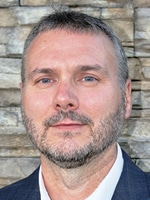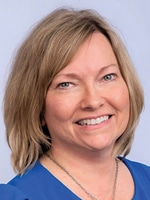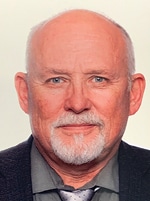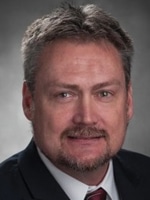February 2022—New year, new variant. For Compass Group lab leaders on a call with CAP TODAY publisher Bob McGonnagle on Jan. 4, omicron was new but the struggles were similar. They spoke of staffing and supplies but also of the CDC’s day-five guidance, crisis planning, instrument downtimes and hard-to-get parts, and doing such things as limiting routine phlebotomy draw times for COVID-positive inpatients. “We’re trying to better utilize dwindling resources on the inpatient phlebotomy side,” said Diana Kremitske, MS, MHA, MT(ASCP), of Geisinger.
The Compass Group is an organization of not-for-profit IDN system laboratory leaders who collaborate to identify and share best practices and strategies. Here is what they told CAP TODAY as the new year began.

Baker
We have now more than 1 million cases in one day in the United States. On New Year’s Eve in Chicago not a single ICU bed was available at the University of Chicago hospitals. Joseph Baker, what’s going on at Baylor Scott & White in Dallas?
Joseph Baker, VP of laboratory, Baylor Scott & White Health, Dallas: This morning, as a system, we’re around a 38 to 40 percent positivity rate. We have a couple of sites doing variant testing that can track S gene dropouts. We’ve seen quite the wave over the past three to four weeks, specifically at Baylor University Medical Center. We went from zero omicron to 30 percent, to 50 percent, and now we’re at 100 percent. Our central Texas area is a little behind our north Texas hospitals, seeing around 60 percent omicron.
Staffing continues to be a struggle and a challenge. We were getting help from our nursing partners with specimen collections when we didn’t have the phlebotomy staff at some of our hospitals, and now they’re equally struggling if not more. We have asked our lab leaders to develop a critical staffing plan.
Supplies—there’s not enough. Testing, pipettes, you name it; we’re struggling to get it.
We know we have a mixture now of several variants. Most of the serious cases would seem to be attributed to delta. Peter Dysert, what is your feeling about what we’re told about omicron so far?
Peter Dysert, MD, chief, Department of Pathology, Baylor Scott & White Health, Dallas: Time will answer that question. The biggest issue for us now is making a therapeutic decision in that window of time, if we can tell somebody they have omicron versus delta. Two of three agents aren’t effective in omicron. In trying to conserve those things, we’ve been asked if we can differentiate omicron from delta.
Is that an ongoing exploration as of today?
Dr. Dysert (Baylor Scott & White): Yes, it is. We have the Thermo Fisher QuantStudio, so we screen using S gene dropout, making the assumption that those S gene dropouts are omicron. When we’ve been able to sequence them, when we have reagents, 100 percent of our S gene dropout patients confirmed genetically is omicron.
Greg, tell us what’s going on in New Orleans.
Greg Sossaman, MD, system chairman and service line leader, pathology and laboratory medicine, Ochsner Health, New Orleans: Our point-of-care positivity is about 45 percent in urgent care and ED settings. We do quite a bit of point of care with ID Now. It’s about 30 percent for PCR positivity.
We continue to see issues with the volumes we’re putting through the instruments; there are significant downtimes. They seemingly aren’t necessarily engineered for the volumes we’re using them for now.
Is your servicing of equipment up to snuff or is that also strained given the volumes?
Dr. Sossaman (Ochsner): It is strained because most of the time the engineers are flying in from somewhere else and with flight delays, travel, and weather, it’s been problematic.
Myra Wilkerson, tell me from your medical point of view what’s happening at Geisinger.
Myra Wilkerson, MD, chair of laboratory medicine, Geisinger, Danville, Pa.: This morning our overall system positivity rate was about 38 percent. For ambulatory, it’s about 51 percent positive. We do NGS, but only a small sampling every month to see if there’s a shift. Until now, it hasn’t been a problem; the treatments were all the same. But with the change in the variants and the effectiveness of certain antibody therapy, we may have to start doing more sequencing.
Elective surgeries were canceled until January 15. We’re still running ORs in some of our hospitals but only for critical surgeries.
Lab staffing is a challenge but nursing is the biggest challenge. With physicians and especially surgeons cutting back on their OR schedules, they’re doing either primary inpatient service instead of being just consults, so in a lot of cases the hospitals are devoted to ICU and COVID patients. The other services are covering as primary admitting services. Some surgeons and some of our pathology group are covering vaccine clinics to free up nurses so they can go to inpatient service.
We saw a lot of data late last year about a serious delay in cancer diagnoses. Is that your experience at Geisinger as you look at the data?
Dr. Wilkerson (Geisinger): We haven’t specifically looked at it, but there is a lot of catch-up. The dermatology clinics were shut for several months so they are catching up. One of the biggest things we’re seeing is skin cancers, especially melanoma.
Diana Kremitske, can you comment on the supply chain issues you may be experiencing at Geisinger?
Diana Kremitske, MS, MHA, MT(ASCP), VP, Diagnostic Medicine Institute, Geisinger, Danville, Pa.: The PST and SST tubes are still an issue. We have several mitigation plans in place, including converting to plain red tops, which requires extra processing time on the front end. We’re doing that on the outpatient side in select locations staffed by laboratory personnel to handle the front-end processing work prior to shipping those specimens to the core laboratory. We’re monitoring that week to week to understand what our supply on hand is. Right now, we’re about a 13- to 14-week supply on hand for the entire system for SST and PST tubes but still working on continuing those mitigation plans.

Kremitske
We are refreshing our communications about the utility of inpatient phlebotomy, especially on COVID-positive patients and persons under investigation for COVID who are inpatients, and limiting those routine draws to two times a day: 4 AM to 8 AM for morning rounds purposes and then in the evening at about 4 PM to 8 PM. Of course, if situations warrant a stat or there’s a worsening clinical situation, the laboratory would respond to that as requested. We’re trying to better utilize dwindling resources on the inpatient phlebotomy side by limiting routine draws to those hours for COVID-positive patients.
How long has that been in effect?
Diana Kremitske (Geisinger): We put that into effect in 2021, and we felt with the recent surge we needed to refresh that communication. At times we start to see an inappropriate use of stats just to get it done. So we reached out to our chief medical officers and nursing officers to help us with that communication and encourage providers to use the time frames for routine blood draw times. It’s difficult for the phlebotomists to manage large worklists on a case-by-case basis, despite being aided by technology. We need our clinician partners to support us in the appropriate utilization.
I’m going to turn to Dwayne Breining for a report from Northwell.

Dr. Breining
Dwayne Breining, MD, executive director, Northwell Health Laboratories, New York: We’re still seeing a vertical rise in new cases in New York. There is not enough testing to go around. Everybody’s turnaround time is extended out. We’re doing about 90 percent of PCRs within 48 hours of receipt in the lab. We did 25,000 tests yesterday and if I had 25,000 more, they would be taken up in an hour or two.
One-third of our tests overall are positive. We had set up genotyping about three weeks ago to differentiate between omicron and delta, thinking it was going to be significant because of the therapeutic choices, and in one week’s time we saw it go from 20 to 80 percent omicron. We’ve been at virtually 100 percent for the past two weeks.
It used to be only about 10 percent of our COVID inpatients were fully vaccinated; now about one-third are. It’s mostly with comorbidities and other such things, but this variant does seem to get through the vaccines easier than the others.
Jim Crawford, do you share the opinion of some that the CDC has muddied the waters with its pronouncements regarding 10 days versus five?
James Crawford, MD, PhD, professor and chair, Department of Pathology and Laboratory Medicine, and senior VP, laboratory services, Northwell Health, New York: The challenge the CDC faces, which is trying to extrapolate from surveillance data into policy and medical recommendations, is enormous. I have been in conversation with the CDC and the National Cancer Institute—which is the sponsor for SeroNet [NCI Serological Sciences Network], which is the national consortium on antibody science and practice in the United States—about how the United States can better leverage its data to inform public policy and the practice of medicine. The challenge is connecting the dots to be able to make sense of massive streams of data in the midst of a population that is churning its way into the new year. I am empathetic to the CDC for the challenge it faces. And my own interpretation is, there is a pressing need to have health care workers be able to return to work in the midst of COVID racing through their communities and taking people off the job.

Dr. Crawford
For the health care industry, and I would use Northwell as the example, to translate public policy as expressed by the CDC into specific recommendations for a health system workforce is something that Dr. Breining and I depend on—particularly with regard to the importance of laboratory testing for our workforce and of what we are calling “friends and family,” not just the team member. The health care workforce is so stressed now 22 months into this pandemic. And then we have essential workers across the whole span of civic responsibility and the rest of our society. So my fundamental response to you is, I am empathetic to the CDC to try to keep people on the job to fulfill the requirements of our society. And, yes, it is difficult and confusing.
Lauren Anthony, can you fill us in on your experience in Minneapolis?
Lauren Anthony, MD, system laboratory medical director, Allina Health, Minneapolis: In our system, we have eight COVID-19 platforms going and none of them have an S gene target. We’re going with the health department’s statement that we’re rapidly converting to omicron. Our formularies decided to not offer the monoclonal antibody therapies that are less effective with that variant, so those aren’t orderable anymore and there is an allocation process for the effective therapy. We have a scarce resource team and the state has a scoring and application mechanism to show equity in dispensing those doses. So we are not doing anything specific for the omicron variant. It wouldn’t be practical, even if we brought in a platform with an S gene target to see if it dropped out. We couldn’t manage all the testing.
At this point, 30 percent of our symptomatic outpatients are COVID positive, but our pre-op is about four to five percent positive. That’s much higher than it had been.

Dr. Anthony
Now that people are doing home testing, there might be a patient who comes in for surgery and says, “I had a home test positive and I’ve isolated for 10 days.” What do you do with them? Because if they did have COVID, testing positive doesn’t mean much. We’re having discussions about managing patients in that context who did their own test, had symptoms, and said they isolated on their own.
We’re having crisis planning for staffing and it’s involving multiple levels of the organization; it’s affecting lab. Whatever plans we have, each day we get new resignations, and today we’re getting more people out with COVID. With the crisis staffing, it impacts the level of care we have in some places. We’re having to cut back or centralize some testing that normally we wouldn’t.
There are multiple supply issues. We have incident command structures set up for the tubes, staffing, and blood shortage.
Tell us more about crisis planning.
Dr. Anthony (Allina): We have a system group and a format that we go through with different triggers that could be pulled at different times—for example, triggers where we might be able to manage things by shifting people around. But then we get to the point where we can’t manage things by shifting people around, and that’s when we start to shift the work around and that affects the services we put on site.
We’re standardized across the system—same equipment, procedures, electronic medical records—so a person can volunteer to work at a different site. But the issue then is, what about when they volunteer to go to a different site but they’re not, for example, a blood bank person? We say while that person is covering that hospital—and smaller hospitals might only have one person on duty—they would only be able to issue emergency group O red cells. That requires communication with the team at the site and careful coordination so everybody knows what they would do with a bleeding patient and what their expectations for blood availability are during those hours when that volunteer is the only person there. Managing multiple things like this with fewer resources and with disruptions is creating the majority of our work now.
People throw out solutions to problems, but you have to connect the dots. If we did this, would it really increase the staff we have available? It requires a lot of talking and coordination to try to figure out what strategies are worth looking at or trying. At this point, it’s taking all of our resources.
Bob Carlson, tell us what’s going on at NorDx and MaineHealth.
Robert Carlson, MD, medical director, NorDx, MaineHealth: We had our highest number of positives yesterday—more than 1,000, with an overall positivity rate of around 21.8 percent. The asymptomatic population, which includes some of the prescreening, is running around 18 to 19 percent. We’ve run a couple of variant panels over the past few months. It used to be 100 percent delta. About a week and a half ago, we could see the non-delta starting to creep in, which we’re assuming is omicron. We’re running a plate today and I expect omicron to be the vast majority of cases.

Dr. Carlson
Staffing remains critical for the phlebotomy PSCs as well as the lab personnel. We run our COVID testing on the QuantStudio using 96-well plates. It’s extremely manual. We will hit our 1 million COVID tests mark in the next two weeks, and for a manual process to have that many tests is phenomenal. I am proud of our staff but they are weary.
Barb Bigler, what’s going on at ACL Labs in Chicago?
Barbara Bigler, president, ACL Laboratories, Rosemont, Ill., and West Allis, Wis.: We’re testing almost 50,000 samples weekly with the ability to do more. We have experienced some problems with the rapid PCR testing availability, which would improve if we had unlimited access to all the testing possible. Our central labs are running 24/7. We are running about a 35 percent positivity rate.

Bigler
In Illinois the prevalent virus is delta whereas in Wisconsin it’s omicron. Illness and hospitalization are spiking in Illinois a little more than in Wisconsin, but Wisconsin is busy with hospital beds with the limitations of having only so many beds and staff. In addition to labor shortages, we are experiencing staffing issues due to illness.
Let’s hear from your colleague Mick Runnoe.
Mick Runnoe, VP of Laboratory Operations, ACL Laboratories, West Allis, Wis.: We have 63 laboratory employees out with COVID. It becomes difficult to manage all the different sites and locations, which is why I paid keen attention to Diana’s report about changing hours of draw on the hospital. I’m going to take that back.

Runnoe
We’re not sequencing at this time, so we’re not able to identify variants. Our medical staff is having the same issues with the monoclonal antibody, and they’ve decided to pull that off the shelf with the 75 percent omicron in Wisconsin. Illinois numbers are catching up.
John Waugh, can you weigh in from Detroit?
John Waugh, MS, MT(ASCP), system VP, pathology and laboratory medicine, Henry Ford Health System, Detroit: The most disruptive are absences, and absences on very short notice. Children get COVID and mom and dad get it two days later, and now they’re all out of work. At Henry Ford we have more than 200 employees out this morning. But that doesn’t tell the full story because there were another 300 in the phone queue awaiting decisions, and our employee health clinics are overrun trying to evaluate these individual cases and balance the 10-day, seven-day, five-day changing guidance.
We have not reinstituted presurgical or preprocedural testing. We’re still doing surgeries. Our positivity rate for the last week has been 40 to 45 percent of all patients tested. We have a low availability of monoclonal antibodies. I heard this morning there are 30 doses and they will all be used immediately and be gone today.
The other challenge is, we have a number of temporary nursing agency contracts ending with the turn of the year, and a number of them are not being renewed. Or the ones being renewed are featuring new staff who have to be onboarded and oriented to all of our systems here.
We did validate patient self-collect of nasal samples, which we think will be helpful as we get that fully instituted in our employee health clinics and some of our screening areas. That was done by taking a provider collect for 250 samples and then a patient collect for 250 samples and comparing the results of the two. We had a more than 98 percent correlation, and that was for a group with ages ranging from 19 to 94. There was a high level of confidence that patients and employees will be able to self-collect samples, saving the process of nasopharyngeal.
I’m sure you share Jim Crawford’s empathy for the CDC and the dilemma it faces. But as a consumer, as a family man, do you agree with me there’s a bit of confusion on the line for a consumer?
John Waugh (Henry Ford): There’s a lot of confusion out there. The dilemma is the environment we’re operating in is not on play; it’s on fast-forward and things are changing too rapidly. Some of the information people receive are forecasts on news media, and it takes time to evaluate that at a local and state level versus the federal level, and then even within our own organizations to determine whether we’re going to make a change in our policies and then communicate that internally to stakeholders.
Stella Antonara at OhioHealth, tell us what’s going on in Columbus.
Stella Antonara, PhD, D(ABMM), medical director of microbiology, OhioHealth: Our overall positivity rate throughout our system is more than 45 percent, consistently for the past week, and our urgent care sites reached a positivity rate of 55 percent. At this time, we’re wondering whether it’s worth testing anymore. We’re at the highest level of performing daily testing, more than 2,500 per day throughout our system. We never stopped doing preadmission testing. Even through the delta surge, our preadmission testing for our asymptomatic people was relatively low; it may have reached six percent at the height of the delta surge, but at this point we’re seeing close to 20 percent.
We do not have sequencing capability in-house. One of the assays we use is the TaqPath assay. We monitor the S gene dropout for the samples we run, and the dropout rate is above 60 percent, sometimes 80 percent. CDC projects for our area to be at about 70 percent for omicron, consistent with the rates we see.
Eric Carbonneau at TriCore, I’m hoping the sun and New Mexico weather will give us a nicer story.
Eric Carbonneau, MS, MT(ASCP), director, laboratory operations, Woodward Labs and TriCore Research Institute at TriCore Reference Laboratories: We’re at 23 percent positive and omicron is rising. We’re still in crisis care for our hospitals.
We have a lot of the film industry here in New Mexico and we’ve done their surveillance. We’re starting to see the film crews coming in as positive and potentially impacting their ability to work. So we’re seeing a lot of that impact in our community, as well as requests for employer-based testing and surveillance.
We’re seeing, in addition to the supply shortages we’ve all seen, a supply shortage in getting parts to New Mexico. For instance, we have chemistry analyzers that are down today, and we have service engineers here trying to figure out if FedEx can get the parts here.
New Mexico is a fragile state socioeconomically and there’s a great public health and population health challenge.
Eric Carbonneau (TriCore): Yes, there is. We are hoping to launch remote collection sites to go to those patients. We did that last year with the National Guard during the surge. TriCore is looking at how we can do that, and we’re awaiting funding options.
Clark Day, what’s it like in Indianapolis?
Clark Day, VP of system laboratory services, Indiana University Health: We launched the ability to test our quarantined team members on day five with antigen testing. We typically have more than 1,200 team members in quarantine out of almost 38,000. We’re testing 300 to 400 team members each week, and about 54 percent of them are positive. Since launch we’ve been able to return about 150 or more people to work four or five days sooner each week by performing this antigen testing.
Our emergency departments are overrun with people showing up “just to get a test.” We have upstream communication and public relations messaging to encourage people to visit our remote sites. We’re having to refresh that messaging and reinforce it to relieve our EDs.
As for weekly testing of our own unvaccinated team members—about 10 percent of our workforce—we have decided not to pursue that, as once-weekly testing is inadequate to detect omicron and the burden on our laboratory leaders and frontline team members to test twice a week would be excessive.
I’m going to end with you, Stan Schofield. You have been a good barometer and predictor of events. Can you share your perspective on the potential peaking and then diminishment of the surge late in January?
Stan Schofield, president, NorDx, and senior VP, MaineHealth: Based on the data I have read out of England, Europe, and South Africa, around Valentine’s Day will be our peak. We’re still going up every day. It is dominant omicron. For us, I think we’ll decline Valentine’s Day and the last two weeks of February, and I hope we hold out till then, because we have denial of care, denial of service, staff are out. There was confusion around the five-day rule, but that’s getting solved quickly because it goes into effect tomorrow when we do antigen testing on day five and return to work on day six. We have hundreds of people out at the system level who are fully vaccinated and COVID positive, and many people who are boosted are sick. My money is on Valentine’s Day, and it’ll be a sweetheart deal for me if that’s true.